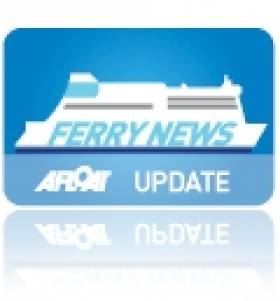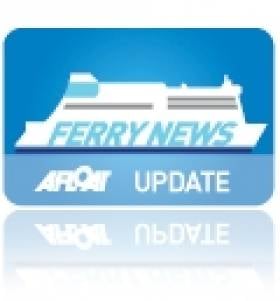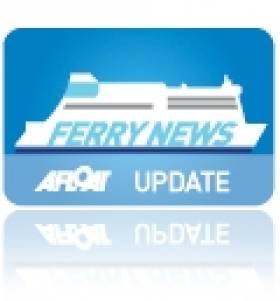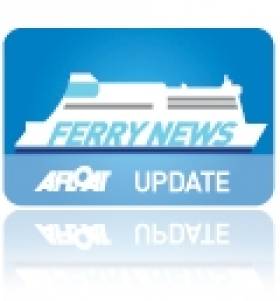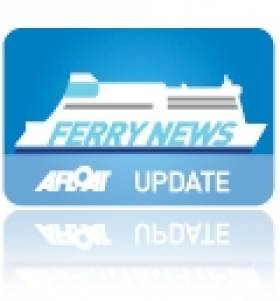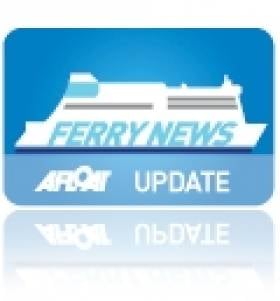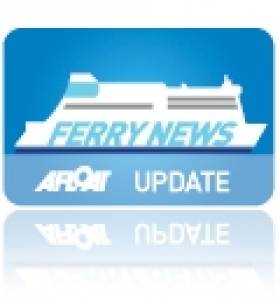Displaying items by tag: LD Lines
LD Lines Close UK-Spain Routes from Poole
#UK-SpainClosures - LD Lines which closed the Irish-Spanish route last month as previously reported on Afloat.ie also ceased operations on UK services to northern Spain last weekend.
The French operator had only launched the Poole-Gijón less than a year ago and beforehand Poole-Santander in 2013.
According to the Bournemouth Echo, a spokesman for LD Lines said: "We originally had sailings available to the end of September but suspended bookings for the period beyond September 7 when we started reviewing the future of the routes.
"As a result, a relatively small number of customers are affected by the closure of the routes. All such passengers have been transferred to another UK - Spain operator on sailings as close as possible to their LD Lines booking".
LD Lines had been operating a once-weekly return services between Poole and Gijón, and a round trip every weekend between Poole and Santander. Both were aboard the Norman Asturias, the largest ferry to enter the port, which can take up to 500 passengers, 200 cars or 110 freight vehicles.
It is understood that the passenger service was extremely popular but the freight service had declined. Brittany Ferries started a competing service from Portsmouth in March.
Afloat.ie adds that LD Lines are now reduced to operating a single service across the Bay of Biscay, on the St. Nazaire-Gijón route by ro-pax Norman Atlantic. This vessel had served also on the Irish leg of the landbridge route to Spain via the mid-west French port.
LD Lines to Cease Ireland-France-Spain Services
#IrelandSpainFerry – Ireland's first historic ro-ro ferry connection to Spain via a France 'landbridge' service launched in January by LD Lines as previously reported, is to cease operations with the final sailing departing Rosslare this Friday, writes Jehan Ashmore.
In a statement released to Afloat.ie, "LD Lines can confirm that we will be withdrawing our Rosslare - St.Nazaire - Gijon services after the 29 August sailing from Rosslare. Bookings had only ever been taken until 5 September and sailings for the final week of sailings were suspended as long as March whenever the decision was taken only to operate the service for the peak summer season.
The company spokesperson added, "Any passengers booked on the last two sailings have been transferred to the Rosslare - Cherbourg route. Only a very small number of passengers were affected by this decision." For ferry sailing information click HERE.
Norman Atlantic, (ex. Scintu See Photo) a 26,904 tonnes ro-pax ferry, is due to make her final inbound sailing to Rosslare tomorrow (28 August) and remain overnight in the Wexford port.
As referred above, her final outbound sailing from Rosslare on Friday (29 August) departs at 21.00 to St. Nazaire. The 22 hour crossing is scheduled to arrive at 19.00 the following day in the south Breton port downriver from Nantes along the Loire estuary.
LD Lines 'Motorways of the Sea' route allowed for a stopover en route in mid-west France before completing the journey to Spain at the port in the northern region of Asturias. Passengers had the added option of visiting resorts in western France and throughout Spain.
The French operator's core market was to capture the Irish-Iberian freight trade by offering a more cost effective and environment friendly alternative. A notable benefit particular to freight drivers was avoiding longer distances across France and EU haulage directives.
Norman Atlantic's 550 passenger ferry is of the popular Italian Visentini built ro-pax design. She can accommodate 110 freight vehicles or 150 trailers along with 200 tourist cars. As also reported, she had been previously off-service for three-months for dry-docking and other duties until she resumed the Irish route in June.
LD Lines Finally Resumes Ireland-Spain Service via France
#IrelandSpainFerry –Tonight, LD Lines finally resume their Ireland-Spain route via western France served by ro-pax Norman Atlantic, writes Jehan Ashmore
As previously reported, LD Lines announcement of the route returning to service follows an absence of more than three months due initially to dry-docking and for other un-disclosed reasons.
In January the French operator started the first ferry connection between Ireland and Spain with a stopover en route call at St.Nazaire before completing the journey to Gijón in the northern region of Asturias.
The once weekly 22-hour service calls to Rosslare on Thursdays and departs from the Wexford port on Fridays.
Since her arrival to Rosslare Eurport last evening, the ro-pax Norman Atlantic has remained in port for almost a full day, as she departs this evening at 9pm.
She is scheduled to arrive tomorrow at St. Nazaire on at 1900. From the mid-west Atlantic French port she heads for Gijón with an arrival time on Sundays at 1300.
Northbound the vessel departs Gijón on Tuesdays at 2200 and St. Nazaire at 2359 on Wednesdays before arriving back in Rosslare at 21.45 on Thursdays.
The 550-passenger Norman Atlantic caters for tourist traffic and can accommodate both regular freight types and most abnormal loads benefitting hauliers.
Her sister Norman Astuarias operates additional sailings yet only on the French-Spanish link.
#IrelandSpainFerry –Good news for those intending to travel between Ireland and Spain as LD Lines are to resume Rosslare route services starting on 20 June to St.Nazaire, France and onward to Gijón in northern Spain, writes Jehan Ashmore.
The first ever Irish-Spain route (landbridge via western France) was originally launched in January, however a period of dry-docking in March was also followed by an extended absence of service from the continental routes. However, LD Lines return of the first inbound sailing by ro-pax Norman Atlantic departs Gijón on 17 June followed by St. Nazaire on 18 June and arriving to Rosslare 19 June.
The corresponding first southbound sailing from Ireland departs Rosslare on the next day of Friday 20 June departing 21.00 and arriving St. Nazaire on Saturday at 1900hrs before reaching the final destination of Gijón in the Asturias region of Spain on Sundays at 1300hrs.
Northbound the vessel departs Gijón on Tuesdays at 2200 and St. Nazaire at 2359 on Wednesdays before arriving in Rosslare at 21.45 on Thursdays.
Gary Andrews of LD Lines stated; "We are delighted to confirm the resumption of our service, offering Irish hauliers the easiest routes to Western France and Spain. Beating the French driving ban by arriving in Spain on Sunday evenings, freight is placed ready for Monday morning deliveries across Spain, Portugal, France and further afield."
The routes are operated by the 550-passenger Norman Atlantic which as well as catering for tourist traffic can accommodate both regular freight types and most abnormal loads.
As previously reported, LD Lines also operate routes from Poole to Santander, Poole to Gijon and the direct Saint Nazaire – Gijón service.
LD Lines Ireland-France-Spain Routes Contact Details Here!
#LDlines – LD Lines operators of the Ireland-France-Spain service between Rosslare-St.Nazaire-Gijon is to recommence on 17 June.
As previously reported on Afloat.ie, the reason for the cancelled sailings was due to annual drydocking of ro-pax Norman Atlantic during selected dates and her current operation exclusively on the St.Nazaire-Gijón route.
According to LD Lines website, passengers with bookings up to this date are being contacted regarding transfer, re-booking or refunds. Queries about the service can be made to 33 (0)825 304 304 or +33(0)232 144 729 or by email via the "Contact Us" form on the operator website.
Those passengers intending to travel on the 'landbridge' service to Spain between St. Nazaire- Gijón are advised that a shoulder timetable schedule is currently in place and is operated by Norman Atlantic.Take note to Click this link to download shoulder timetable which is above older timetable on the website page.
She also operates this route along with Norman Astuarias which is out of service according to the shoulder timetable until the summer schedule starts in mid-June.
LD Lines France Route Ro-Pax to Have Annual Dry-Docking
#FerryDryDock – According to LD Lines website, the ro-pax Norman Atlantic is to have its annual drydocking and the following sailings listed below on the Rosslare-St.Nazaire route are cancelled.
Rosslare - St Nazaire: 14 & 21 March
St Nazaire - Rosslare: 12 & 19 March
Click for LD lines contact details.
To consult the latest sailing schedule on the Rosslare-St. Nazaire route click HERE.
For those travelling on the route beyond France of the 'landbridge' Spain service of St. Nazaire- Gijón, they should be advised that 'certain' sailings are also cancelled.
Also operating the St. Nazaire-Gijón route is sister ro-pax, Norman Astuarias which will continue to serve to her sailing schedule.
To consult the latest sailing schedule on the St. Nazaire- Gijón route click this link.
As previously reported on Afloat.ie, Norman Atlantic as the former Scintu in January had launched LD Lines new Ireland-France-Spain routes, the services becoming the first ever to link all three countries. That first sailing by Scintu to Rosslare was a once-off as was renamed Norman Atlantic to reflect her trading route network.
Norman Atlantic is pictured here along the inner pier of Rosslare Europort. She is clearly recognisable as one of the Visentini built designed ro-pax vessels.
The Italian shipyard built ferries are designed primarily with ro-ro freight in mind and a relatively small passenger capacity compared to conventional car-ferries. The ro-pax have become increasingly popular in recent years, notably earlier this year by other operators trading from the Wexford port.
#IrelandSpain – LD Lines new Ireland-France-Spain routes service ferry Scintu is tonight making her maiden inbound voyage to Rosslare Europort with an arrival expected just after 21.00hrs, writes Jehan Ashmore.
As reported last night on Afloat.ie, the Scintu departed St.Nazaire at midnight bound for Rosslare. The ship starts the first ever ferry service linking Ireland-west France and northern Spain. The new route was hailed as a 'valuable new landbridge' by Minister for Transport Leo Varadker when in November he announced the new Irish-Iberian service.
To reflect her new Rosslare-St.Nazaire-Gijon route operations, the 26,904 tonnes Scintu with a capacity for almost 500 passengers and 195 vehicles is to be re-named Norman Atlantic within the month.
Norman Atlantic will operate the 22-hour sailing between Rosslare and St. Nazaire (Montoir-de-Bretagne) on the banks of the Loire. She then continues from the mid-western French port on the second leg of the Irish-Iberian service to Gijón in the Astuarias region of northern Spain.
A sailing schedule sees the 2009 Italian built ferry operate a single weekly round-trip service on the Rosslare-St.Nazaire route in which the first outward bound sailing departs Rosslare tomorrow night at 21.00hrs. In addition the ferry operates two round-trips per week on the St.Nazaire -Gijon 16 hour route.
The Bay of Biscay route will also be served by sister Norman Astuarias which as reported has opened other new routes recently between the UK and Spain. The routes are Poole-Santander and also starting this month a Poole-Gijon route.
Both these new Irish 'Motorway of the Seas' routes linking to France and Spain, will open up a whole new dimension to Irish tourists and freight customers.
The 186m long Norman Atlantic was built by Visentini Shipbuilders. She has comfortable cabins and passenger facilities of a bar, restaurant, shop and lounges.
Currently the ferry does not carry 'foot' passengers on the Rosslare-St. Nazaire and St. Nazaire- Gijón routes, though according to a LD Lines spokesperson this option have not been entirely ruled out.
LD Lines are no stranger to the Irish market, as the French owned company initially imported trade vehicles using the freight-only ro-ro vessel, NMT Elise which also ran from Rosslare. This service also developed into a passenger ferry service that began in 2008 but instead operated to Le Havre.
LD Lines Launch First Ever Ireland-France-Spain Ferry Service
#IrelandSpain – As previously reported on Afloat.ie, LD Lines launches a new passenger and freight ferry service linking Rosslare Europort in Ireland, the France west coast port of St.Nazaire and the northern Spanish port of Gijón.
Click for LD lines contact details.
The new link sees the ro-pax ferry Scintu (2006/26,904grt) make her debut at midnight tonight with an inward bound sailing to Rosslare from St. Nazaire as part of the first ever ferry service linking Ireland, western France and northern Spain.
The new route is to forge new trading links combined with cost-saving advantages and environmental benefits for passengers and hauliers.
For the tourist market the link to Gijón makes destinations in Spain and Portugal easier than ever to drive to and for the freight market, by passing the UK landbridge, quicker access to and from the Continental mainland.
In addition the France West coast port of St.Nazaire is ideally located for popular French holiday locations such as Brittany, La Baule, La Rochelle and Bordeaux as well as providing easy accessibility for freight traffic between mainland Europe and now with the new service, Ireland.
Welcoming the new service, John Lynch, General Manager Rosslare Europort, said,"This new service, the first Ro Ro connection between Ireland, France and the Iberian peninsula, will open up new opportunities for trade between Ireland, France, Spain and Portugal, with the potential for inbound tourism to Ireland also benefiting significantly."
The new service will depart Rosslare on Fridays at 21:00 ; depart St.Nazaire to Gijón on Saturdays at 22:00 ; return from Gijón on Tuesdays at 22:00 ; depart St.Nazaire to Rosslare on Wednesdays at 23:59 with an arrival time in Rosslare on Thursdays at 21:15.
This represents a major extension of LD Lines' "Motorway of the Seas" Atlantic network, coinciding with other new services as previously reported, between Poole and Santander, which began in November 2013. A Poole – Gijón is to start in early January and the existing France – Spain route linking St.Nazaire and Gijón, which was introduced in 2010.
Christophe Santoni, CEO of LD Lines commented, "The new service will offer a value-for-money direct route between Ireland, France and Spain and in addition to making European destinations more accessible, will give the tourism and freight markets greater choice."
LD Lines' new network of ferry services will be operated by two sister ships Norman Asturias and Scintu. The modern Ro Ro and passenger vessels, built in 2008/2009 by the Visentini Italian shipyard, each have capacity for up to 500 passengers, 200 cars and 110 freight vehicles or 150 trailers. On board facilities include 120 cabins, bar, restaurant, shop and a full range of passenger entertainment is being developed and introduced in the months ahead.
Fares for the Rosslare – Gijón service start from €579 for a car and two passengers including cabin.
Rosslare – St.Nazaire fares start from €199 for a car and two passengers or €249 for a car and two passengers including cabin, noting this introductory fare on the Ireland-France route is limited to the first 200 car passenger bookings.
LD Lines Launch New UK-Spain Route
#NewROUTE – LD Lines has begun a new UK-Spain route between Poole, Dorset and Santander in Cantabria served by ro-pax Norman Asturias with a capacity for up to 500 passengers, 200 cars or 110 freight vehicles, writes Jehan Ashmore.
As of mid-afternoon today, the 27,414 tonnes ferry entered the western approaches of the English Channel having departed Spain yesterday at 18.00hrs and is due to dock in the Dorset port this evening at 19.00hrs.
Norman Asturias was deployed to the new twice weekly return operated route having been displaced from the St. Nazaire (Montoir-de-Bretagne)-Gijón route which is now operated by Scintu, a sister of the popular Visentini Italian built ro-pax design ferries. The French-Spain route is part of the EU's 'Motorways of the Sea (MOS) programme to divert traffic away from congested roads and transferring onto faster vessels (i.e. the ro-pax design).
The new 26-hour route represents a major development to LD Lines creation of an Atlantic ferry network, providing new links to serve the UK, French, Spanish and Portuguese freight. In addition catering for UK tourism markets and making regions such as the Algarve within easier reach.
To cover the long distance route, the 24-knot Norman Astuarias was deployed to the route. Among her sisters are Celtic Horizon and her predecessor on Celtic Link Ferries Rosslare-Cherbourg route the Norman Voyager. In mid-October she carried out berthing trials in Poole on behalf of her fleetmate.
LD Lines which is part of the Louis Dreyfus Group had tipped their toes into the Irish ferry market several years ago on the short-lived Rosslare-Le Havre operation. The service was only run at weekends as Norman Voyager also and remains running weekday sailings between the French port to Portsmouth.
The revival of the Rosslare route to Normandy had not been operated for many years when Irish Continental Group's (ICG) ferry division Irish Ferries ran the route served by St. Killian II until 1997. Following LD Lines departure from the Irish route, Celtic Link quickly seized a charter option of the 2008 built ferry until current route vessel Celtic Horizon came on the scene two years ago.
The introduction of LD Lines onto the Biscay run brings competition to long established operators Brittany Ferries whose services also run between Santander and the UK (Plymouth and Portsmouth). As previously reported on Afloat.ie, Brittany Ferries took over the Portsmouth-Bilbao route following P&O's exit of the Iberian service served by the former ICG owned Pride of Bilbao.
On another Irish related note the new LD Lines route will sharpen and focus minds again on previous calls to have a similar ro-pax operated service linking Ireland to Iberia.
As also reported, the Port of Cork has been actively involved in attempts to introduce such a service through the PROPPOSE partnership between the Irish port and Gijon.
Currently goods totalling 110,000 tonnes move between Ireland and Iberia by road via the UK and France with the consequent cost, environmental impact and susceptibility to French toll-roads. In addition that country's banning of HGV traffic at weekends and the planned implementation of Ecotax for trucks from 1 January 2014.
New Celtic Link Ferry on Re-Positioning Voyage off Africa
CLF are to charter Celtic Horizon for a five-years and the 25-knot capable vessel will takeover the existing thrice-weekly round trip sailing schedule from ro-pax Norman Voyager. Between 2 January -19 February 2012, CLF will be the only continental ferry operator running services as rivals Irish Ferries will be taking their cruiseferry Oscar Wilde for annual dry-docking. To read more click HERE.
In addition there will be no sailings between Cork-Roscoff, as operators Brittany Ferries last sailing for this year is 29 October, served by 'flagship' Pont-Aven. The 2012 season starts in late March.
Celtic Horizon is the first vessel to be named with a 'Celtic' prefix of part of their ferry operations, since the company brought European Diplomat from former route operators P&O (Irish Sea) in 2005. The freight-ferry renamed Diplomat, served Celtic Link Ferries until 2009. Since then she has been on charter in the Caribbean until this summer when she was sold to the breakers in Alang, India. To read more click HERE.
As for Celtic Horizon, she was built in 2006 and spent her last season this year as Cartour Beta while on charter to C&T's routes between Naples and Sicily, to read more click HERE. The 186m ro-pax is believed to be heading for Gibraltar while en-route to Rosslare.
During her Irish service, she will maintain Italian registry of Bari whereas her predecessor Norman Voyager changes flags from the UK to that of the French tricolour. Both vessels are similar as they share a ro-pax design which has proved popular for Italian shipbuilders Cantieri Navali Visentini.
The 2008 built Norman Voyager of 26,904grt is to revert to LD Lines operation and used on their 'Motorways of the Seas' St. Nazaire-Gijon service, though she was to enter on the Marseilles-Tunis route. Her new role on the Franco-Iberian route sees the replacement of Norman Asturias.



























